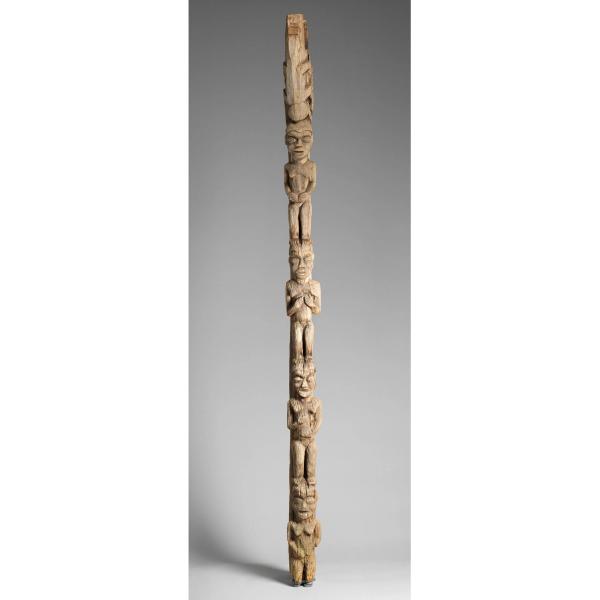Palace pillar with female figures
Artwork Details
- Title: Palace pillar with female figures
- Artist: Grassfields artist
- Date: Late 19th–early 20th century
- Geography: Cameroon, Big Babanki
- Culture: Babanki
- Medium: Wood, pigment
- Dimensions: H. 97 × W. 6 × D. 7 1/4 in. (246.4 × 15.2 × 18.4 cm)
- Classification: Wood-Architectural
- Credit Line: Fletcher Fund, 1972
- Object Number: 1972.4.29a
- Curatorial Department: The Michael C. Rockefeller Wing
Audio

1544. Palace pillar with female figures, Grassfields artist
Ikem Stanley Okoye
ANGELIQUE KIDJO (NARRATOR): The rectilinear palaces of the Cameroonian Grassfields chiefdoms were collections of buildings, each linked to the next by a series of courtyards. The richly decorated interiors feature elaborately carved doorjambs and roof-supporting pillars like this one.
IKEM OKOYE: In my very first encounter with rectilinear palaces, it instigated imagining myself as a young child growing up in a palace and waking up in the middle of the night, and walking through the palace in which you would be surrounded by sculpted figures. You can imagine the moonlight shifting the shadows, how that might frame and construct one’s consciousness if you were residing in a space in which sculpture could be present as forms on the structural pillars that are also holding up the building. It’s kind of hard to say, “Well, is the pillar the sculpture, or is the sculpture a pillar?”
I’m Ikem Stanley Okoye, associate professor at the University of Delaware. I’m an art and architectural historian.
ANGELIQUE KIDJO: This post once stood at the entrance of the private quarters of the fon, or king, of Big Babanki.
But the post itself is more ephemeral. Palace decorations were often moved to different locations or removed completely in favor of new commissions.
IKEM OKOYE: There is clear evidence of removals in which new ideas get put in place, even if the overall building remains. Within the history even of a stable dynastic lineage, the palace was undergoing change.
There was a great investment and value put on sculptor artists within this universe. There would have been a constant demand for the production of these kinds of objects.
More Artwork
Research Resources
The Met provides unparalleled resources for research and welcomes an international community of students and scholars. The Met's Open Access API is where creators and researchers can connect to the The Met collection. Open Access data and public domain images are available for unrestricted commercial and noncommercial use without permission or fee.
To request images under copyright and other restrictions, please use this Image Request form.
Feedback
We continue to research and examine historical and cultural context for objects in The Met collection. If you have comments or questions about this object record, please contact us using the form below. The Museum looks forward to receiving your comments.